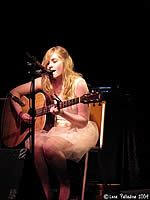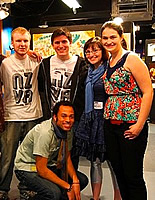
PROFILES
All-Ages Movement Project
Seattle, WA
by Laura Cockman, 17, Y-Press
Whitney Ballen, 18, has a variety of artistic talents, ranging from painting to making books to writing and performing original songs. For the past four years she’s been able to channel her energies through the Old Firehouse, a teen center in Redmond, WA, that is supported by the All-Ages Movement Project, a network that strives to make music and arts venues accessible to young people who are typically overlooked in favor of the over-21 crowd.
Through the Firehouse and the Project’s connections to other all-ages venues, Whitney has interned at area teen centers and even painted a mural that serves as a stage backdrop. She also has played at benefit shows, such as Viva Vera in Seattle, in order to raise money for music and art projects, and at auction shows to raise money for charity projects, such as building wells in impoverished countries.
What’s your definition of youth activism?
I think it’s just youth standing up for what they believe in. There’re so many different institutions that kind of drill different beliefs into our heads just because that’s what we’ve grown up with. But I feel like youth activism is really standing up for what you believe in versus what your school or your family or your religion has taught you.
How has the All-Ages Movement Project benefited you?
Well, definitely knowledge about local music. I gained a lot of friendships through the local scene here in Seattle, as well as knowledge about just like things going on in my community I guess. A lot of all-ages venues around here really support the community through having benefit shows or fundraisers for local companies or local families and such. So I gained a lot of knowledge about what’s around me.
What would be your greatest success?
Last year in April, we released a CD of about 14 local bands, all from my area code, which is 425. And all the bands ranged from 13 to 19 years old, and each of the bands we recorded at the Old Firehouse.
I organized all of that, all the recording and all of the mastering and the mixing, the replication of it and made the CD cover for it, got donations from a lot of local companies to help really put it out. So that’s probably one of the biggest projects I’ve done through the All-Ages Movement. I wouldn’t have ever had the confidence I guess or the help or opportunity to do that if it weren’t for the local support.
.
What effect has technology had on your organization?
Well, I think that not only my projects, but with all kinds of projects within the area, Facebook and MySpace and all those are used so often that it’s kind of hard to advertise something on them. For example, if there’s a band that has a show coming up, everyone will post things, but it’s just like crazy.
It’s a good way of spreading information. … If people see it and they like it, they’re going to get involved. So I think it’s really helped. I think it’s really changed the All-Ages Movement, just a lot more people have been able to find out about it.
by Danielle Hensley, 13, Y-Press
DreamYard is Chelsea John’s outlet. She became involved in third grade when the organization came to her school to teach art and she’s now a high school junior bringing art to others.
DreamYard is a nonprofit organization based in the Bronx that provides arts education to Bronx schools and creative programs outside of school. Unlike most art education programs, DreamYard brings in professional artists who team up with teachers to give students the best possible art education.
Chelsea, 16, writes, acts and is involved in the visual arts. In particular, she volunteers with two of DreamYard’s four out-of-school programs: The Bronx Poetry Project and the Bronx Acting Ensemble. Youth involved in these projects reach out to the community and help with different issues. For example, Chelsea recently finished an AIDS awareness project in which the group performed street theater and hosted an HIV awareness party.
For Chelsea, the biggest benefit of DreamYard is learning a whole new way of understanding the world. “I feel like through the arts, I get to see things from other points of views, with different eyes,” she said.
What’s your biggest success?
I don’t think I can name just one. I guess the success would be like touching so many people and having so many people know about DreamYard, know about what we’re doing and understand like the topics that we’re talking about. Just having the word out there and getting other people to notice the problems around them.
Why do you think it’s important to keep art alive in the community?
I think art is just a tool in learning and it’s so useful in respecting yourself and having a creative outlet. It’s really important to keep that alive because without it, you have fewer options. It’s also a connection to the community.
What’s been the biggest challenge in using art to raise awareness for social issues?
I feel like the biggest challenge is trying to balance the art and the fun of it with like the activism components and the seriousness of the topics. That’s always a problem, to get people to see past the entertainment and what pleases them to what we’re really trying to teach.
by Danielle Hensley, 13, Y-Press
Allison Correll, 18, likes to help people. She also likes to take photographs. When she joined Neutral Zone, she got to do both. Neutral Zone is an artistic teen center that gives teens opportunities to take up new hobbies and find new talents. For Allison, photography was just a hobby until she joined the Visual Arts Council, a division of Neutral Zone, which helps their community through visual art and gives young adults the opportunity to show their art to the world for the first time. 
Neutral Zone was founded in 1998 by teens who wanted a place to explore new ideas and skills and help the community. One of the first projects Allison did on the council was to donate several photographs to the local homeless shelter, which put them up in every room. In addition, last spring the zone put on a show, Frame of Mind, in collaboration with the University of Michigan’s Depression Center to raise awareness of teenage depression and other mental illnesses. It featured speakers, performers, poems and art from the Neutral Zone that showed how to deal with mental illness through art.
Describe how art shows benefit young artists.
The first one that I really worked on was called Royal Hullabaloo. It was over 200 pieces of art with over seven different high schools participating. It’s a really great feeling being able to see people put their art up for display for the first time. And I know when I was able to show my art for the first time, it’s very empowering and it gives you that sense that oh, you know, I could do this for a living.
What are some of the challenges faced by arts programs?
Lack of funding has been a big part. Lots of school programs lose funding for art, and that’s very sad. … And I think there’s a lot of parental pressure sometimes that your kids can’t be artists because they’re not going to be able to make enough money, or it’s not a stable job or a respectable job sometimes. And I think that’s very sad that parents can’t sometimes support their children.
Why do you think it’s important to keep art alive in the community and accessible to youth?
I think it’s important because art is the basis of so many things, and it can teach you so much stuff about you and about the world around you, about your community. … It’s about other people and other things, how other people are seeing things. And you become so much more open-minded when you can look at other people’s art, especially when you help other people create that art.




